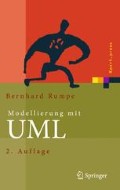Zusammenfassung
Objektdiagramme haben in der UML/P die Rolle, Strukturen auf exemplarischer Basis zu modellieren. Sie sind daher besonders geeignet, statisch unveränderliche Strukturen in dynamischen objektorientierten Systemen oder spezielle Situationen darzustellen, die etwa als Vor- oder Nachbedingung bei Tests verwendet werden. In diesem Kapitel werden Objektdiagramme eingeführt und ihr methodischer Einsatz diskutiert. Die Integration mit der OCL führt zu einer „Logik für Objektdiagramme”.
Die Dinge haben nur den Wert, den man ihnen verleiht.
Molière
Access this chapter
Tax calculation will be finalised at checkout
Purchases are for personal use only
Preview
Unable to display preview. Download preview PDF.
Literatur
C. Amelunxen, A. Königs, T. Rötschke, and A. Schürr. MOFLON: A standard-compliant metamodeling framework with graph transformations. In A. Rensink and J. Warmer, editors, Model Driven Architecture – Foundations and Applications: Second European Conference, ECMDA-FA 2006, Bilbao, Spain, July 10-13, 2006, volume 4066 of Lecture Notes in Computer Science (LNCS), pages 361–375. Springer, 2006.
K. Bergner. Spezifikation großer Objektgeflechte mit Komponentendiagrammen. Dissertation. CS Press, München, 1997.
K. Beck and E. Gamma. Test-Infected: Programmers Love Writing Tests. JavaReport, July 1998.
K. Beck and E. Gamma. JUnit: A Cook’s Tour. JavaReport, August 1999.
F. Buschmann, R.Meunier, H. Rohnert, P. Sommerlad, and M. Stal. A System of Patterns. Pattern-Oriented Software Architecture. John Wiley & Sons, 1996.
H. Ehrig, G. Engels, H. Kreowski, and G. Rozenberg. Handbook of Graph Grammars and Computing by Graph Transformations, Volume 2: Applications, Languages and Tools. World Scientific, 1999.
G. Engels and R. Heckel. Graph Transformation and Visual Modeling Techniques. Bulletin of the European Association for Theoretical Computer Science, 71, June 2000.
G. Engels, J.-H. Hausmann, R. Heckel, and S. Sauer. Dynamic Meta- Modeling: A Graphical Approach to the Operational Semantics of Behavioral Diagrams in UML. In A. Evans, S. Kent, and B. Selic, editors, ≪UML≫ 2000 – The Unified Modeling Language, 3th Intl. Conference, pages 323–337, LNCS 1939. Springer, 2000.
M. Fontoura,W. Pree, and B. Rumpe. The UML Profile for Framework Architecture. Addison-Wesley, 2001.
E. Gamma, R. Helm, R. Johnson, and J. Vlissides. Design Patterns. Addison-Wesley, 1994.
J. Gil, J. Howse, and S. Kent. Constraint Diagrams: A Step Beyond UML. In Proceedings of TOOLS USA’99. IEEE Computer Society Press, 1999.
F. Huber, A. Rausch, and B. Rumpe. Modeling Dynamic Component Interfaces. In M. Singh, B. Meyer, J. Gil, and R. Mitchell, editors, TOOLS 26, Technology of Object-Oriented Languages and Systems. IEEE Computer Society, 1998.
JUnit. JUnit Testframework Homepage. http://www.junit.org/, 2011.
OMG. OMG Unified Modeling Language: Infrastructure Specification, Superstructure Specification; formal/2010-05-03, formal/2010-05-05. Technical report, Object Management Group (OMG),May 2010.
G. Rozenberg. Handbook of Graph Grammars and Computing by Graph Transformations, Volume 1: Foundations. World Scientific, 1999.
I. Weisemöller, F. Klar, and A. Schürr. Development of Tool Extensions with MOFLON. In H. Giese, G. Karsai, E. Lee, B. Rumpe, and B. Schätz, editors, Model-Based Engineering of Embedded Real-Time Systems: International Dagstuhl Workshop, Dagstuhl Castle, Germany, November 4-9, 2007, LNCS 6100, pages 337–343. Springer Verlag, 2010.
Author information
Authors and Affiliations
Rights and permissions
Copyright information
© 2011 Springer-Verlag Berlin Heidelberg
About this chapter
Cite this chapter
Rumpe, B. (2011). Objektdiagramme. In: Modellierung mit UML. Xpert.press. Springer, Berlin, Heidelberg. https://doi.org/10.1007/978-3-642-22413-3_4
Download citation
DOI: https://doi.org/10.1007/978-3-642-22413-3_4
Published:
Publisher Name: Springer, Berlin, Heidelberg
Print ISBN: 978-3-642-22412-6
Online ISBN: 978-3-642-22413-3
eBook Packages: Computer Science and Engineering (German Language)

